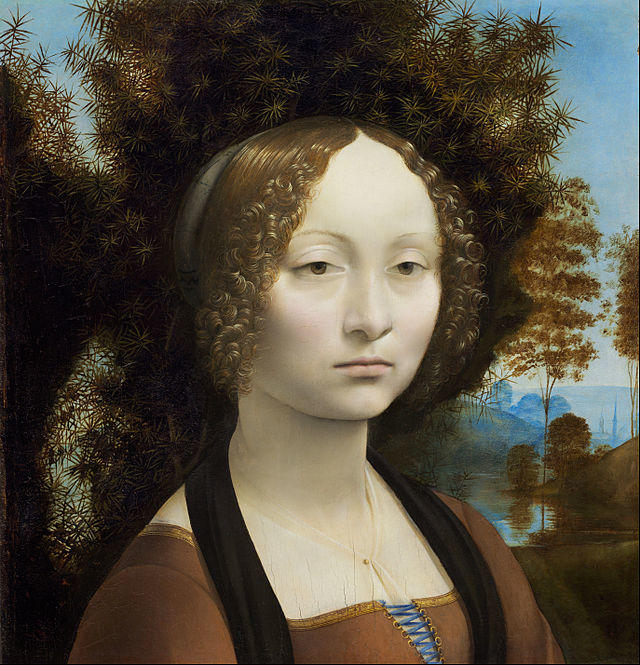Abstract
Leonardo da Vinci’s “Ginevra de’ Benci” portrays powerful styles and principles of design. The artwork also presents different themes such as beauty, chastity, dignity, and modesty. This essay gives a detailed analysis of this masterpiece by Leonardo da Vinci. The essay explores the strengths, elements, and styles of the artwork.
Work of Art and Thesis
The masterpiece “Ginevra de’ Benci” was painted by Leonardo da Vinci. The artist painted it between 1474 and 1476. The painter “used oil on a wooden panel” (Koestler-Grack, 2005, p. 73). The country of origin is Italy. It is currently found in the National Gallery of Art in Washington.
Thesis statement
Leonardo da Vinci uses the best elements of art and principles of design to give the painting “Ginevra de’ Benci” powerful themes such as beauty, chastity, dignity, and modesty.
Media, Technique, and Style of the Work
This work of art presents two unique techniques. The first technique is known as sfumato. This “style uses glazes in different tones of color in order to create a transition from light to dark” (Jiminez, 2013, p. 18). The other “technique is chiaroscuro” (Jiminez, 2013, p. 18). Leonardo combines “landscape and portrait to produce this masterpiece” (Hand, 2004, p. 67). He uses oil on wood to produce the painting. The artwork portrays the historical and cultural aspects of Italy during the 15th century.
The aristocrats occupied a unique position in the society. The painting was aimed at commemorating Ginevra’s marriage. The Latin motto “VIRTUTEM FORMA DECORAT” symbolizes Ginevra de’ Benci’s virtues. Some virtues such as beauty and austerity were meaningful during the time. Marriage was also taken seriously in Florence (Brand & Korsmeyer, 2011).

Description of the Painting
This artwork presents the portrait of Ginevra de’ Benci. She appears beautiful and brilliant. There is “no smile on her face” (Brand & Korsmeyer, 2011, p. 54). Leonardo’s combination of landscape and portrait is noticeable on this painting. The painter uses wood and oil in a professional manner. This approach gives the painting an even tone. The size of the painting makes it emotional.
Elements of Art
The painter uses “curves and lines in order to create distances between different points” (Hand, 2004, p. 66). The painter uses various marks to separate different objects. Such lines have given the portrait a 3D effect. Leonardo da Vinci uses different natural shapes. Learn ado da Vinci “has textured and patterned different shapes in order to give the painting a powerful meaning” (Hand, 2004, p. 67). The painter uses different properties of color. Leonardo uses hue and intensity effectively. He also uses intensity to create a 3D effect. The painter “creates value by adding black and white to different colors” (Hand, 2004, p. 67). The use of space is noticeable in Leonardo’s “Ginevra de’ Benci”. The painting has three grounds: foreground, middle ground, and background. This element is achieved through the use of a landscape approach. The painter has also used texture. This masterpiece has different textures. For example, the woman’s face appears smooth.
Principles of Design
Leonardo da Vinci’s paintings are characterized by powerful principles of design. The artist has also used the concept of unity. The parts of the painting are combined to form one unique image. Leonardo da Vinci uses different objects in order to create variety. Balance is achieved through the artistic integration of different components (Hand, 2004). The mountains and trees correspond to each other. The painter has arranged the above parts in a regular manner. The painting has a unique focal point or emphasis. The viewer is compelled to focus on Ginevra de Benci’s face. The woman’s image makes this masterpiece meaningful to the viewer.
The parts portrayed on the painting are proportional to each other. The concept of perspective is employed to produce this work of art. The painter has also used the concept of scale. He has achieved this goal by adjusting the parts in a proportional manner. Movement is achieved through the use of tone and contrast. The patterned repetition of objects such as trees adds rhythm and movement to the painting (Brand & Korsmeyer, 2011). The artist uses value, hue, and color to create motion.
Meaning of the Work
This painting identifies most of the issues embraced by many people throughout the Renaissance Period. Many portraits depicted the lives of women from wealthy families. The painting shows that “Ginevra de’ Benci comported herself with dignity and modesty” (Hand, 2004, p. 87). Dignity was something precious during the time. Ginevra’s beauty is a sign of greatness. The juniper tree also presents Ginevra’s name. The tree is also a sign of chastity (Jiminez, 2013).
Personal Response
I have appreciated the above painting by Leonardo da Vinci. I have also understood the major achievements of Leonardo da Vinci. The painting also portrays some of the values embraced by many people during the Renaissance Period. The painting shows clearly that Leonardo was a great artist. The painter has used different elements of art (Brand & Korsmeyer, 2011). Leonardo da Vinci used different principles of design to strengthen the meaning of the portrait. I am therefore planning to analyze more artworks by Leonardo da Vinci.
Reference List
Brand, P., & Korsmeyer, C. (2011). Feminism and Tradition in Aesthetics. Philadelphia, PA: Penn State Press. Web.
Hand, J. (2004). National Gallery of Art: Master Paintings from the Collection. New York, NY: National Gallery of Art, Washington. Web.
Jiminez, J. (2013). Dictionary of Artists’ Models. New York, NY: Oxford Press. Web.
Koestler-Grack, R. (2005). Leonardo Da Vinci: Artist, Inventor, and Renaissance Man. New York, NY: Longman. Web.